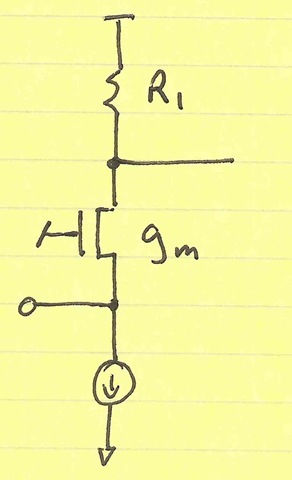In this post, I will show an evolution of a trans-conducting LNA (rather than a voltage-gain LNA). This is a prime example of current-mode circuit design, which has benefits in terms of linearity—especially for low-voltage scaling in RFCMOS design.
Conventional common-gate LNA
Consider the conventional common-gate LNA on its own:

This LNA consists of an input at the source of the MOS transistor (or emitter of a BJT) , a current-source to bias the transistor, and a resistor load. This configuration is typically used in broadband receivers (cable tuners, TV tuners, software-defined radio).
The gain of this stage is Av = gm×R1. This seems like a reasonable stage to produce a gain and therefore overcome noise.
Each of these circuits is presented as a single-ended version. However, there is absolutely no reason not to implement them as differential circuits. I merely draw them single-ended here to get the point across without obfuscating the primary ideas. If there is interest in seeing what the differential versions look like, please post a request in the comments section.
CMOS LNM employing voltage-mode LNA
However, consider what happens when we couple this LNA into a CMOS switch-mode mixer:
 The ⊗ symbol represents a set of commutating MOS mixers, typically capacitively coupled, to separate the dc bias voltages at the output of the LNA and the input of the post-mixer amplifier (PMA). You can essentially ignore then in this analysis, and just assume that they ideally convert from RF to baseband (direct conversion).
The ⊗ symbol represents a set of commutating MOS mixers, typically capacitively coupled, to separate the dc bias voltages at the output of the LNA and the input of the post-mixer amplifier (PMA). You can essentially ignore then in this analysis, and just assume that they ideally convert from RF to baseband (direct conversion).
Consider the loss term R1/(R1 + R2). It doesn’t have to be there.
Trans-conducting LNA
If we replace R1 with a current-source load and merely omit R2, we’d have something like this:
 You’ll note that the previous loss term is now gone. We have greatly enhanced the gain at essentially no cost. Furthermore, the resulting architecture is even more linear: there is little swing at the output of the LNA; the summing junction of the PMA linearizes the LNA by presenting a low impedance to the LNA.
You’ll note that the previous loss term is now gone. We have greatly enhanced the gain at essentially no cost. Furthermore, the resulting architecture is even more linear: there is little swing at the output of the LNA; the summing junction of the PMA linearizes the LNA by presenting a low impedance to the LNA.
Due to the high output impedance of the LNA, a common-mode feedback circuit is necessary. I have detailed two ways of doing that.
References
Matt Miller and I came up with these ideas at Motorola in 2004. We were not the only ones. Other people within Motorola came up with the same idea. In addition, I had seen it published somewhere around 2004—I thought by Michiel Steyaert or Thomas Lee. Despite my recollection, the closest references I have seen available are: “A 72mW CMOS 802.11a direct conversion receiver with 3.5dB NF and 200kHz 1/f noise corner” (albeit using an inductor load instead of PMOS loads) and “A 1 V 1.1 GHz CMOS integrated receiver front-end” (with a folded Gilbert cell mixer).
[…] detailed the use of current-mode circuits before. It’s possible to treat this as a special case of the voltage-mode output analysis, […]
hi poojan,
i love your analog desgn insight posts.
‘current mode design’ is a bit of a black art for me. and there is only ONE book in entire Amazon on it !
Can you pl write an article on rough rules of thumb to use for (1) when to use current mode and (2) how 2 go about designing in current mode.
can you pl also write a post on why the OTA [operational trans-conductance amplifier] failed to ‘take over the world’ ? what caused its demise ? and is it still used in some neiche ? what is that neiche ?
I know about the 4-20 ma current loop of Induatrial, and the teleco current loop for POTS onhook-offhook detection.
ashvini, new delhi , india.
@Robert Tso:
You’re right about the impedance going high outside of the gain-bandwidth of the op-amp. Typically, you’ll want to put a capacitor on the inputs of the PMA to maintain a low impedance when the PMA’s op-amp (OTA) runs out of steam (and to suck out any LO injection). The addition of such a capacitor is not trivial as it can really screw up stability.
I also recall that there’s a filter configuration (was it Tow-Thomas?) that includes such a capacitor.
I will admit ignorance on many of the details of the BBF, because there was either someone else to do that job (which, I will admit, is the crux of this configuration), or I was always pulled off to other tasks.
If the post mixer amplifier is a low bandwidth amplifier, then it will not do a very good job in presenting a low impedance at the mixer output or at the gm stage output, – so the benefits of improving gm stage linearity would not be realized
The likely advantage of the 2nd schematic configuration is that it allows a filter to be placed between the mixer and baseband amp.